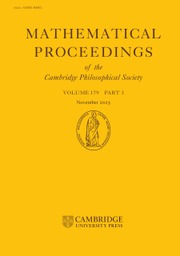Crossref Citations
This article has been cited by the following publications. This list is generated based on data provided by
Crossref.
Northcott, D. G.
1956.
Semi‐regular local rings.
Mathematika,
Vol. 3,
Issue. 2,
p.
117.
Northcott, D. G.
1957.
On the notion of a first neighbourhood ring with an application to theAF+BΦ theorem.
Mathematical Proceedings of the Cambridge Philosophical Society,
Vol. 53,
Issue. 1,
p.
43.
Lech, Christer
1957.
On the associativity formula for multiplicities.
Arkiv för Matematik,
Vol. 3,
Issue. 4,
p.
301.
Yoshida, Michio
1957.
A property of polynomial extensions of rings.
Proceedings of the American Mathematical Society,
Vol. 8,
Issue. 5,
p.
987.
Kirby, D.
1959.
The defect of a one‐dimensional local ring.
Mathematika,
Vol. 6,
Issue. 2,
p.
91.
Rees, D.
1961.
a-Transforms of Local Rings and a Theorem on Multiplicities of Ideals.
Mathematical Proceedings of the Cambridge Philosophical Society,
Vol. 57,
Issue. 1,
p.
8.
Hays, James H.
1973.
Reductions of ideals in commutative rings.
Transactions of the American Mathematical Society,
Vol. 177,
Issue. 0,
p.
51.
Nesselmann, Dieter
1974.
Eine Verschärfung eines Multiplizitätssatzes von D. REES.
Mathematische Nachrichten,
Vol. 59,
Issue. 1-6,
p.
343.
Orecchia, Ferruccio
1980.
One-dimensional local rings with reduced associated graded ring and their Hilbert functions.
Manuscripta Mathematica,
Vol. 32,
Issue. 3-4,
p.
391.
McAdam, Stephen
1980.
Asymptotic prime divisors and analytic spreads.
Proceedings of the American Mathematical Society,
Vol. 80,
Issue. 4,
p.
555.
Shah, Jayant
1981.
Stability of two-dimensional local rings. I.
Inventiones Mathematicae,
Vol. 64,
Issue. 2,
p.
297.
Herrmann, M.
and
Orbanz, U.
1982.
On equimultiplicity.
Mathematical Proceedings of the Cambridge Philosophical Society,
Vol. 91,
Issue. 2,
p.
207.
Ostrowski, Alexander
1983.
Collected Mathematical Papers.
p.
587.
McAdam, Stephen
and
Ratliff, L. J.
1987.
Sporadic and irrelevant prime divisors.
Transactions of the American Mathematical Society,
Vol. 303,
Issue. 1,
p.
311.
Herrmann, Manfred
Orbanz, Ulrich
and
Ikeda, Shin
1988.
Equimultiplicity and Blowing Up.
p.
1.
Herrmann, Manfred
Orbanz, Ulrich
and
Ikeda, Shin
1988.
Equimultiplicity and Blowing Up.
p.
44.
Hochster, Melvin
and
Huneke, Craig
1990.
Tight closure, invariant theory, and the Briançon-Skoda theorem.
Journal of the American Mathematical Society,
Vol. 3,
Issue. 1,
p.
31.
Herrmann, Manfred
Hyry, Eero
and
Korb, Thomas
1996.
Filter-regularity and cohen-macaulay multigraded rees algebras.
Communications in Algebra,
Vol. 24,
Issue. 6,
p.
2177.
Weibel, Charles
2001.
The negative K-theory of normal surfaces.
Duke Mathematical Journal,
Vol. 108,
Issue. 1,
Corso, Alberto
and
Glaz, Sarah
2001.
Geometric And Combinatorial Aspects Of Commutative Algebra.

